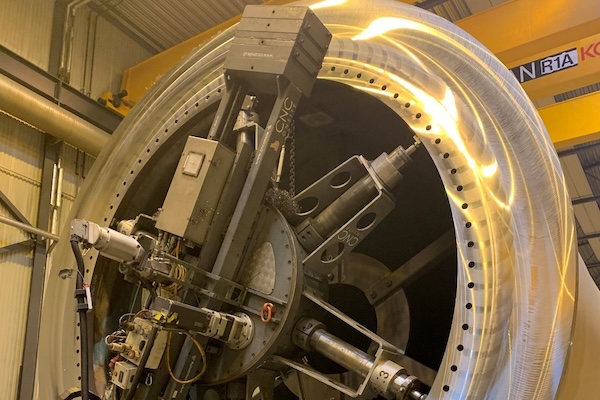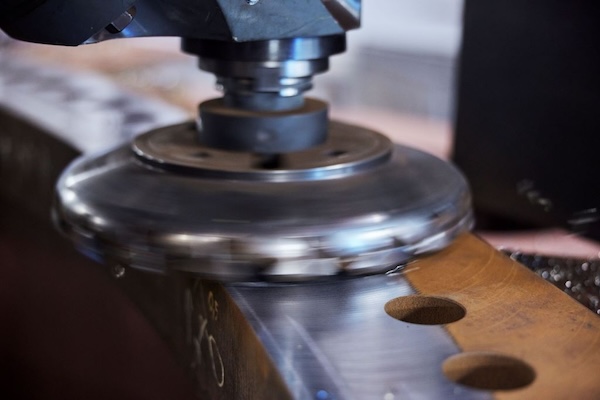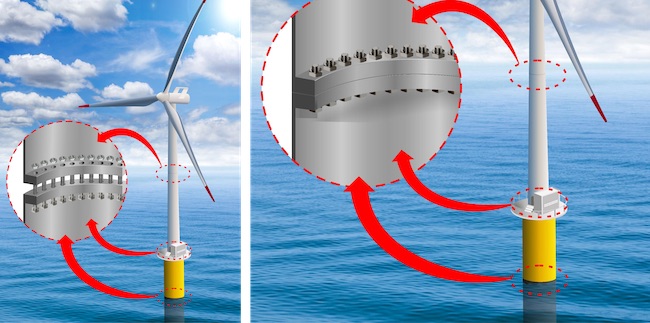Achieving Millimeter Tolerances for Large Wind Turbine Flanges
Wind turbine diameter sizes continue to increase. Today’s large offshore wind turbines flanges for jackets, monopiles, transition pieces, and bottom tower sections can measure up to eight meters across, while 10 meters are forecast in the future. Additionally, floating foundations are foreseen to play a significant role, pushing the limits even further.
Wind turbine tower flanges are critical mechanical joints fastened together by bolts. To ensure correct bolt tightening and to prevent bolts failing due to fatigue, the two connecting flanges must be flat to within a few millimeters, or some cases tenths of a millimeter. Achieving this level of precision presents a technical challenge even for smaller diameter flanges of some 6 meters.

During manufacturing, when flanges are welded to the structure — tower, monopile, transition pieces, jackets or floaters — the heat input can cause twisting and bending in the flange. Sometimes this affects the intended flatness. In this case, the flanges must be adjusted following the welding. Traditionally, these flange surfaces have had to be corrected by hand using heat treatment to remove the skewness. However, the manual method is time consuming and requires significant skills, and it can still be difficult to achieve the level of precision needed.
Betting on precision machining
Manufacturers of foundations and towers are increasingly looking for reliable automated machining methods that not only offer the required precision, but can also be integrated into the production processes.
CNC machining is a suitable solution that delivers benefits in the manufacturing process as it improves precision significantly. The method also reduces the time needed for re-straightening flange, thereby reducing costs and improving throughput. The operation of the CNC machines can either be handled by the manufacturer, or outsourced to specialized CNC machine suppliers who will manufacture the custom-built machine to specifications. Depending on the exact need, manufacturers can choose to either buy the machine or rent it.
Several such custom-made machines for offshore wind turbine flanges are currently being developed in Denmark, the first country in the world to install a wind turbine at sea some 30 years ago. These CNC precision milling machines are available to customers worldwide.
Milling flanges up to 12 meters
One fully automatic CNC-controlled machine, which has been on the market for two years, can mill flanges of up to 10-meters in standard configuration and can be configured for diameters up to 12-meters. This has previously not been possible with a tolerance level below two millimeters.

Using CNC machines for wind turbine flanges brings many benefits. They are fast and precise, and they can handle many different flange designs. Furthermore, they can be used to machine or brush-up flange details likes gasket grooves.
The machines can be built to operate horizontally as well as vertically. As the factory layout and processes vary between manufacturers, this makes it possible to use the machine where it is most efficient for the given manufacturer. Designed to work quickly without compromising the high-precision work, the tool carries out some steps simultaneously to save time. This includes new complex flange designs.
A complex piece of equipment to build, the machine needs to cope with features on large flanges such as tilted or double-tilted surfaces, as well as requirements for parallelism between front- and backside of the flange surfaces. All of these features are important to ensure the integrity of the flange connection during operation; these details can be handled by choosing the most appropriate CNC machines.
The fine tolerances that are achievable using these Danish CNC machines allow designers to create smaller diameter flanges, and offers the potential to obtain maintenance-free bolt connections, which ultimately reduces both CapEx and OpEx for wind farm owners.
Several international foundation and tower manufacturers have already decided to incorporate precision flange milling using CNC machining in the plant. This is because wind turbine manufacturers in the future will probably tighten tolerances further.
Flatness and fatigue can affect bolts
Achieving the best possible fit between the wind turbine tower flange and its base during the manufacturing process reduces the requirement for routine retightening and associated downtime.

Incorrect bolt tension is problematic, as it can cause the bolts to loosen over time. This leads to fatigue in the bolts — at some point, they will start to brake, which ultimately can lead to a complete turbine collapse. Nor are regular bolt inspections favorable. They are expensive, and the tools are heavy from a health and safety perspective.
If combined with precise bolt tensioning methods, the precise flange tolerances achieved with CNC machines can help reduce and even eliminate the need to retighten bolts. This eventually leads to maintenance free connections – reducing OpEx and improving Health, Safety and Environment (HSE)
While the first offshore CNC machining projects in North America are being installed on foundations manufactured outside the continent, the local supply in this region is rapidly developing. It is expected that Danish machines will soon be supplying customized flange milling machines to North America, allowing local manufacturers to obtain the required and optimal tolerances.
Søren Schmidt Kellenberger is Sales Director and Partner at CNC Onsite. [email protected] or by phone at +45 25 53 76 50.
CNC Onsite | cnconsite.dk
Author: Søren Kellenberger
Volume: 2024 July/August








